
The thrushes are a passerine bird family, Turdidae, with a worldwide distribution. The family was once much larger before biologists reclassified the former subfamily Saxicolinae, which includes the chats and European robins, as Old World flycatchers. Thrushes are small to medium-sized ground living birds that feed on insects, other invertebrates and fruit. Some unrelated species around the world have been named after thrushes due to their similarity to birds in this family.
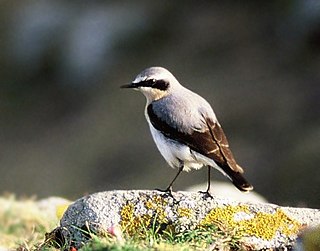
The wheatears are passerine birds of the genus Oenanthe. They were formerly considered to be members of the thrush family, Turdidae, but are now more commonly placed in the flycatcher family, Muscicapidae. This is an Old World group, but the northern wheatear has established a foothold in eastern Canada and Greenland and in western Canada and Alaska.

The Old World flycatchers are a large family, the Muscicapidae, of small passerine birds restricted to the Old World, with the exception of several vagrants and two species, bluethroat and northern wheatear, found also in North America. These are mainly small arboreal insectivores, many of which, as the name implies, take their prey on the wing. The family includes 352 species and is divided into 51 genera.
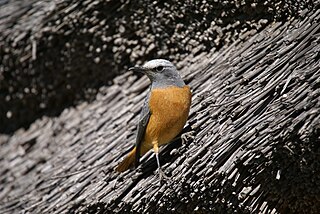
The rock thrushes, Monticola, are a genus of chats, medium-sized mostly insectivorous or omnivorous songbirds. All are Old World birds, and most are associated with mountainous regions.
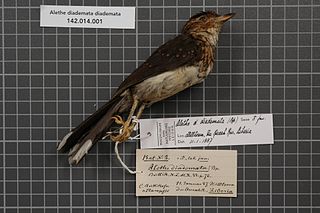
Alethe is a genus of small mainly insectivorous birds in the Old World flycatcher family Muscicapidae that occur in West Africa.

The whistling thrushes comprise a genus Myophonus (Myiophoneus) of the Old World flycatcher family Muscicapidae.

The Siberian blue robin is a small passerine bird that was formerly classified as a member of the thrush family, Turdidae, but is now more generally considered to belong to the Old World flycatcher family, Muscicapidae. It and similar small European species are often called chats. Recent research suggests that this species and some other East Asian members of Luscinia should be classified in a new genus, together with the Japanese and Ryūkyū robins. The genus name Larvivora comes from the new Latin larva meaning caterpillar and -vorus meaning eating, and cyane is Latin for "dark-blue".

The rusty-tailed flycatcher is a small passerine bird in the flycatcher family Muscicapidae. It is found mainly in the northern regions of the Indian Subcontinent and some parts of southwest India, as well as pockets of Central Asia including Uzbekistan and Tajikistan. The species is partially migratory, with the Central Asian populations migrating to India, as far as the southwest Indian coast along the Arabian Sea, to Karnataka and Kerala.

The mountain wheatear or mountain chat is a small insectivorous passerine bird that is endemic to southwestern Africa.
The sombre rock chat is a species of passerine bird in the family Muscicapidae. It is found in Ethiopia and Somalia. Its natural habitat is subtropical or tropical dry shrubland.
The brown-tailed rock chat is a species of bird in the family Muscicapidae. It is found in Chad, Eritrea, Ethiopia, Kenya, Somalia, Sudan, and Uganda. Its natural habitats are dry savanna and subtropical or tropical dry shrubland.
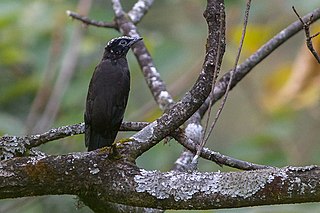
The purple cochoa is a brightly coloured bird found in the temperate forests of Asia. It is a quiet and elusive bird species that has been considered to be related to the thrushes of family Turdidae or the related Muscicapidae. They are found in dark forested areas and is found in the canopy, where it often sits motionless.

The green cochoa is a bird species that was variously placed with the thrushes of family Turdidae or the related Muscicapidae. It is considered closer to the former.
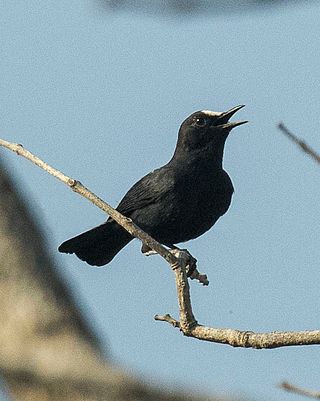
The white-fronted black chat is a species of passerine bird in the family Muscicapidae. It is found in Benin, Burkina Faso, Cameroon, Central African Republic, Chad, Democratic Republic of the Congo, Ivory Coast, Eritrea, Ethiopia, Gambia, Ghana, Guinea, Guinea-Bissau, Mali, Mauritania, Niger, Nigeria, Senegal, Sierra Leone, South Sudan, Togo, and Uganda. Its natural habitats are moist savanna and subtropical or tropical dry shrubland.

Phoenicurus is a genus of passerine birds in the Old World flycatcher family Muscicapidae, native to Europe, Asia and Africa. They are named redstarts from their orange-red tails. They are small insectivores, the males mostly brightly coloured in various combinations of red, blue, white, and black, the females light brown with a red tail. A molecular phylogenetic study published in 2010 led to a reorganization of the Old World flycatchers family in which the two species in Rhyacornis and the single species in Chaimarrornis were merged into Phoenicurus.

The slaty-backed jungle flycatcher is a species of birds in the Old World flycatcher family Muscicapidae. It is endemic to the Philippines. The specific epithet honours the British zoological collector Walter Goodfellow. Its natural habitat is subtropical or tropical moist montane forests. It is becoming rare due to habitat loss.

The grey-chested jungle flycatcher is a species of bird in the Old World flycatcher family Muscicapidae. It is found in Brunei, Indonesia, Malaysia, and Thailand. Its natural habitats are subtropical or tropical moist lowland forests and subtropical or tropical swamps. It is threatened by habitat loss.

The Anthipes flycatchers are a genus of Old World flycatchers.

Chamaetylas is a genus of small, mainly insectivorous birds in the Old World flycatcher family Muscicapidae that are native to sub-Saharan Africa.

Emarginata is a genus of birds in the Old World flycatcher family Muscicapidae that occur in southern Africa.























